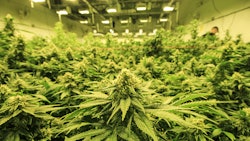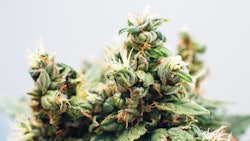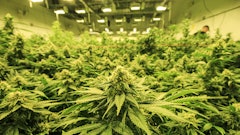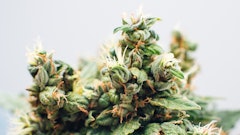
As cannabis is teed up for rescheduling, the Drug Enforcement Administration (DEA) warned about the dangers associated with state-by-state legalization in the agency’s 2024 National Drug Threat Assessment (NDTA) report released May 9.
These threats include an “exponential” increase in THC potency, Chinese and other Asia-based organized crime groups, an increase in accidental cannabis exposure in children via THC-infused edibles, and environmental damages caused by unlicensed cultivation, according to the NDTA.
The DEA dedicated five pages of the 57-page assessment to cannabis, although the report indicated that cannabis is not the focal point of concern for the agency. The DEA’s top priority is to reduce the “supply of deadly drugs” and to defeat two cartels that are “responsible for the vast majority of drug trafficking” in the U.S. The report did not attribute any drug-related deaths to cannabis.
The DEA considers fentanyl—currently a Schedule II drug—the nation’s “greatest and most urgent” drug threat, according to the NDTA. Fentanyl and other synthetic opioids accounted for roughly 70% of the nearly 108,000 drug-related deaths for Americans in 2022, according to the Centers for Disease Control and Prevention.
“The shift from plant-based drugs, like heroin and cocaine, to synthetic, chemical-based drugs, like fentanyl and methamphetamine, has resulted in the most dangerous and deadly drug crisis the United States has ever faced,” DEA Administrator Anne Milgram said in a NDTA press release. “At the heart of the synthetic drug crisis are the Sinaloa and Jalisco cartels and their associates, who DEA is tracking worldwide. The suppliers, manufacturers, distributors and money launderers all play a role in the web of deliberate and calculated treachery orchestrated by these cartels.”
While Sinaloa and Jalisco are regions in western Mexico, and while the NDTA does state that Mexican cartels are responsible for “substantial trafficking” of cannabis, the marijuana section of the assessment more thoroughly focuses on Asian organized crime groups that exploit states that have reformed their cannabis laws. This includes 24 states and Washington, D.C., that have legalized cannabis for adult use and 38 state that have legalized the plant for medicinal purposes.
Specifically, Asian investors have funded unlicensed grows in California, Maine, Oklahoma and Oregon, according to the NDTA. These organizations often operate industrial-scale indoor grows in residential homes, primarily in the western U.S., according to the assessment.
“Many of these home-grows pretend to operate under business registrations granted by state licensing authorities in jurisdictions where marijuana cultivation and sales are ‘legal’ at the state level, but, absent overt evidence such as the trafficking of marijuana across state lines or the commission of nondrug crimes such as money laundering and human trafficking, it can be difficult for law enforcement to immediately identify violations or discover an illegal grow,” according to the NDTA.
In Oklahoma, where medical cannabis was legalized following State Question 788’s passage in June 2018, an unlimited license structure allowed the state’s Medical Marijuana Authority (OMMA) to issue more than 8,000 grower permits given applicants were at least 25 years old, had a $2,500 check and at least 75% of their owner interests were Oklahoma residents. However, many nonresident applicants received their cultivation permits by skirting the rules via paying off “ghost owners.”
In recent years, however, legislative and law enforcement actions have led to a tightening of the belt: Oklahoma now has active licenses for 3,805 growers, 2,121 dispensaries, 1,133 processors and 80 transporters, according to the OMMA. These numbers are still high, especially for a medical-only market. In California, a state of roughly 10 times the population of Oklahoma, there are roughly 5,200 active cultivation licenses and 1,240 dispensaries to serve its adult-use market, according to the California Department of Cannabis Control.
Still, the unlimited license structure in Oklahoma continues to provide an attractive marketplace for drug traffickers who don’t necessarily play by the rules, according to the NDTA. In January 2024, a federal jury in the Western District of Oklahoma convicted two Chinese nationals of drug trafficking conspiracy connected to trafficking nearly 28 tons—or 56,000 pounds—of cannabis shipped from an Oklahoma grow facility licensed by the OMMA.
“Oklahoma has one of the largest illegal marijuana industries in the United States, and the FBI recognizes the devastating impact these illicit operations have on our economy and the safety of our communities,” FBI Oklahoma City Special Agent in Charge Edward J. Gray said in a press release at the time.
For comparison, Michigan dispensaries sold roughly 79,000 pounds of dried cannabis flower per month in 2023 to supply the nation’s second-largest adult-use marketplace.
“Chinese and other Asian drug trafficking organizations collect millions of dollars in illicit drug proceeds from cultivating and trafficking marijuana, and the money is used to fund other criminal activities, to include trafficking in other drugs, money laundering and human trafficking,” according to the NDTA. “The traffickers and investors also protect their illicit marijuana cultivation sites through violence. Booby traps and weapons are found at most outdoor grow sites to discourage intrusion by wildlife, law enforcement and thieves.”
Also, on Aug. 8, 2023, the DEA Dallas Division confiscated more than $2.8 million in cash, firearms and cannabis when it, along with local law enforcement and the IRS, executed eight search warrants on residential and business locations associated with four Chinese nationals in connection to trafficking cannabis from a grow operation in Oklahoma, according to the NDTA.
In addition to organized crime, the DEA’s assessment called attention to an increase in THC potency in cannabis, including an average of roughly 1% THC in 1977, 5% THC in 1997, 9.5% in 2007, 14% in 2017, and 16% in 2022, according to the University of Mississippi’s Potency Monitoring Program. These percentages are specifically for cannabis samples seized by the DEA.
While licensed dispensaries regularly carry flower products that test in the 20% to 30% THC range, lawmakers in states that have recently legalized cannabis, or have considered legalization, vocalize their concerns over the potencies in concentrated THC products, such as oil, dabs, wax, resin or shatter, that may contain up to 90% THC in many states. These products are created by extracting THC from the cannabis plant. The extracted THC is also infused into edible products that must have certificates of analysis and serving sizes in milligrams in regulated marketplaces.
However, accidental consumption is often tied to hemp-derived delta-8 THC products, which are unregulated, untested and sold outside licensed cannabis dispensaries—in places like smoke shops, gas stations and convenience stores—and sometimes mimic popular candy that’s attractive to children. In licensed cannabis markets, this type of packaging is prohibited.
“THC-infused products closely resembling candy, snacks or cereal are responsible for thousands of medical emergencies in children,” according to the DEA’s assessment.
The assessment cites a study published in January 2023 in the journal Pediatrics, which reported that accidental cannabis exposure in children younger than 5 years old increased 1,375% from 2017 to 2021. Eighty-seven percent of the exposures, from more than 7,000 cases analyzed, occurred in the child’s own home, according to the report.
This exposure spike occurred during a period that included the 2018 Farm Bill’s passage, which federally legalized hemp beyond state pilot programs. As Congress works toward reauthorizing the Farm Bill this year, many cannabis industry stakeholders are calling on lawmakers to address a “loophole” in the 2018 legislation that has allowed hemp-derived intoxicating products to proliferate in the U.S. Delta-8 THC, in particular, is synthesized from CBD, the main nonintoxicating compound found in hemp and cannabis plants.
While the Food and Drug Administration issued a warning statement in September 2021 regarding the “serious health risks” associated with delta-8 THC, and while intoxicating hemp-derived products now often contain a warning label, dangers still persist, according to the NDTA.
“The concern remains that children will unknowingly eat THC-infused products, regardless of warning labels, because the products mimic the taste and appearance of the actual product, and the packages look nearly identical to the legitimate product’s packaging,” according to the assessment.
Finally, the NDTA emphasized the environmental damages often associated with unlicensed cannabis cultivation. These operations are usually found on public lands and use toxic fertilizers and pesticides that endanger plants and wildlife and contaminate water supplies.
The environmental impacts caused by these unregulated operations were reported extensively by CBT in July 2021, when more than 400 law enforcement officials seized $1.2 billion of cannabis harvests and plants in Southern California during a 10-day eradication operation that resulted in 131 arrests.
“These sites are mainly located in remote, difficult-to-access areas and can be expensive for cultivators to maintain but are also challenging for law enforcement to detect and eradicate,” according to the NDTA. “Both indoor and outdoor grows also require abnormal amounts of water and electricity, which are often stolen or diverted from public utilities. This practice significantly raises legitimate consumer costs and increases the risk of fires because of overloaded transformers and lack of water.”


























